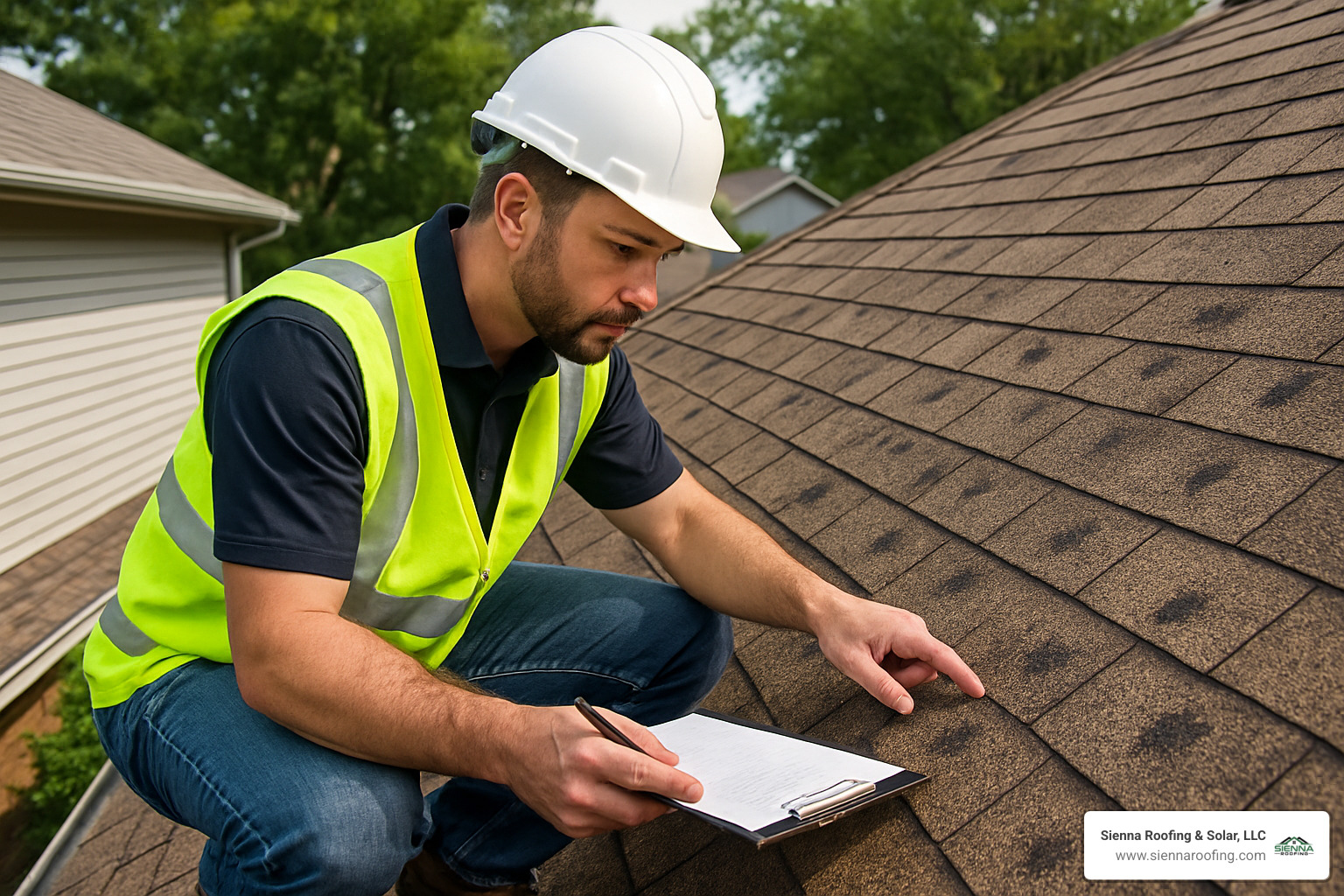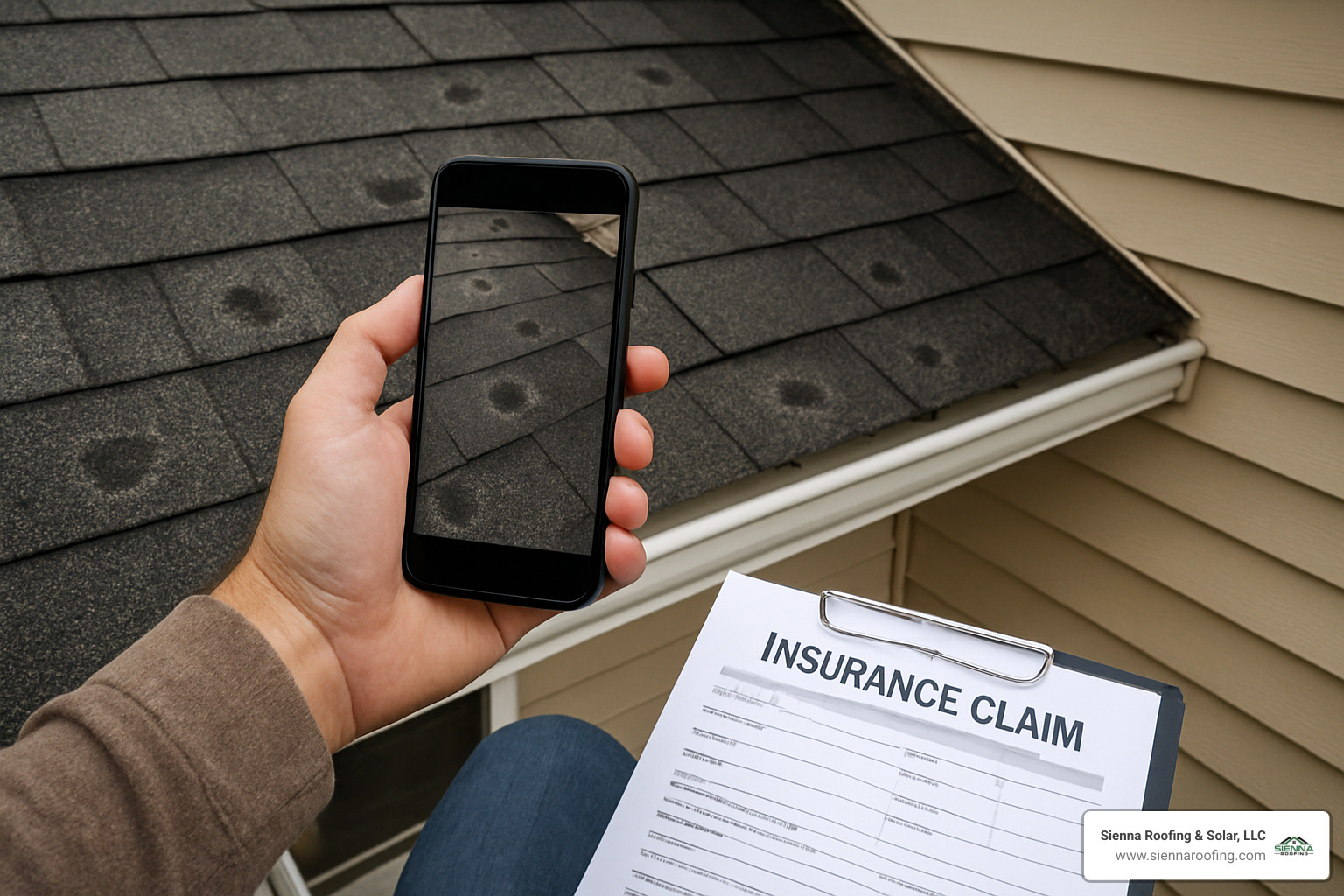The Anatomy of Hail Damage: What to Look For
When I assess storm damage, I treat the roof like a crime scene. As a leading roofing company in Sugar Land, we know that hail size matters, but so do density, wind speed and direction, roof material, age, and slope. A golf-ball stone falling straight down is very different from the same stone hurled sideways by 60 mph wind.
Before climbing a ladder, scan your property. Dented gutters, pockmarked A/C fins, or torn window screens are blinking arrows that your roof probably took a hit too.
What are the key signs of hail damaged shingles on asphalt?
About 80 % of Sugar Land roofs use asphalt shingles. Look for:
- Granule loss – dark, smooth spots where rock has been knocked away.
- Bruising – soft areas that feel like an apple bruise; may hide mat fractures underneath.
- Shiny asphalt – fresh exposure contrasts with surrounding matte shingles.
- Cracks or tears – severe hits can break the shingle outright.
- Random pattern – real hail never lines up neatly.
How does hail damage appear on wood shingles?
Wood can’t bruise, so hail leaves splits, punctures and splintering. Fresh breaks expose bright orange-brown wood that hasn’t had time to weather gray. Impacts are typically round or oval and appear randomly across the slope.
Is It Hail or Something Else? Distinguishing True Damage
Not every blemish comes from hail:
- Normal aging – even granule wear, dull asphalt.
- Blistering – raised bubbles from heat.
- Manufacturing defects – identical problems across many shingles.
- Foot traffic or birds – localized, linear, or isolated holes.
True hail evidence is always random and usually comes with collateral damage elsewhere on the property.
Assessing the Severity of Hail Damaged Shingles
Cosmetic dings and functional damage look similar from the ground, which is why a professional roof inspection after any big storm is worth its weight in gold.

Inspectors examine sample grids (about 100 sq ft each) to calculate the percentage of damaged shingles and to check decking, underlayment, and flashings you can’t see.
How Hail Size and Storm Conditions Impact Your Roof
- 0.75 in. (dime) – rarely serious, but may bruise older shingles.
- 1 in. (quarter) – visible granule loss and bruising on most roofs.
- 1.25 in.+ (half-dollar or bigger) – immediate risk of cracks and leaks; call an expert right away.
Wind can increase impact velocity dramatically, so even small stones can punch above their weight.
Why Even Minor Damage Can Lead to Major Problems
Lose the granules and you lose your roof’s UV sunscreen. Micro-fractures open pathways for water, and small leaks grow into rotted decking, ruined insulation, and mold. Fixing those secondary issues often costs far more than replacing a few shingles today.
Beyond the Shingles: Checking for Collateral Damage
Clues that confirm hail size and direction:
- Dented gutters / downspouts
- Impact marks on vents, chimney caps, skylights
- Torn window screens or dented A/C fins
- Nicks in siding, decks, or patio furniture
These breadcrumbs help your inspector—and your insurer—verify the storm story.
Your Next Steps: Repair, Replacement, and Insurance
Time starts ticking the moment the hail stops. Missing the insurance window—or letting damage worsen—can get expensive fast.

- Document everything – photos of shingles and collateral hits, storm date & time, and any broken pieces you find.
- Schedule an inspection – a written report from a qualified roofer carries weight with adjusters.
- File your claim promptly – most carriers allow up to a year, but waiting months invites disputes about cause.
To Repair or Replace? Making the Right Call
If damage covers less than roughly 10 % of the roof, targeted roof shingle repair is usually enough.
Above 10-12 %, labor costs and inevitable shingle breakage tip the scales toward a complete new roofing installation. A full system replacement also resets your warranty clock.
Navigating Your Homeowners Insurance Claim
Policies differ, but most cover functional hail damage minus your deductible. Meet the adjuster with your contractor present, review the estimate carefully, and don’t be shy about requesting a second look if something seems off. Hold off on permanent repairs until the carrier gives written approval—temporary tarps are fine if water is getting in.
Proactive Protection: Minimizing Future Hail Damage
You can\u2019t stop Texas hail, but you can toughen your roof against it\u2014 and in many cases, you can even turn Mother Nature\u2019s fury into an opportunity to lower insurance premiums and extend the life of your roof.
Impact-resistant materials
- UL 2218 Class 4 shingles \u2013 polymer-modified asphalt that flexes instead of fractures, surviving impacts that would destroy standard 3-tab products.
- Metal roofing \u2013 may dent, but rarely leaks after hail and can last 40\u201370 years with minimal maintenance.
- Synthetic slate & shake \u2013 lightweight composites engineered to absorb impacts while replicating high-end curb appeal.
Because these coverings dramatically reduce claim frequency, many carriers now offer 10\u201335 % insurance premium discounts for homes that install them; ask your provider and keep product receipts for proof.
Extra lines of defense
- Hail guards for HVAC units \u2013 inexpensive wire cages or louvered panels keep condenser fins from getting pummeled.
- Impact-rated skylights and solar panels \u2013 modern laminated glass can shrug off 2-inch stones, reducing future leak points.
- Upgraded ridge vents & flashing \u2013 thicker gauge metals resist denting, preserving proper ventilation after a storm.
Maintenance matters
- Trim overhanging tree limbs that can break and strike the roof.
- Ensure proper attic ventilation so shingles stay flexible rather than brittle.
- Keep gutters clear to prevent water backup and ice dams (yes, even in Texas winters).
A modest annual maintenance plan costs far less than one hail-triggered leak. For a step-by-step checklist, the National Weather Service hail safety tips page offers a homeowner-friendly overview that complements our local recommendations.
Taking these proactive steps doesn\u2019t guarantee zero damage, but they stack the odds heavily in your favor\u2014and when the next Sugar Land hailstorm rolls through, you\u2019ll sleep easier knowing your roof is equipped with the best armor available.
Frequently Asked Questions about Hail Damaged Shingles
What size hail causes functional damage to shingles?
Generally 1–1.25 in. stones (quarter to half-dollar) are the tipping point for healthy asphalt shingles. Older or brittle roofs, wood shingles, and wind-driven storms can suffer at smaller sizes.
Can hail damage be hard to see from the ground?
Yes. Bruising, granule loss, and micro-fractures often hide until you’re on the roof and can feel the shingle surface. Assume nothing—schedule a professional Roof Inspection after any notable hail event.
How long do I have to file an insurance claim for hail damage?
Most Texas policies allow one year, but filing within 30–60 days avoids questions about whether the damage is storm-related or normal wear. Document the storm date, get an inspection, and act quickly if you intend to file.
Conclusion
Recognizing hail damaged shingles is one of those skills you hope you’ll never need, but when that inevitable Texas hailstorm rolls through Sugar Land, you’ll be grateful you know what to look for. After helping hundreds of homeowners steer storm damage over the years, I can tell you that knowledge really is your best defense against costly repairs down the road.
The most important thing to remember is that time is your friend—and your enemy. Act quickly after a hailstorm to identify and document damage, but don’t panic into making hasty decisions. That random pattern of dark spots on your shingles isn’t going anywhere, but waiting months to address it definitely will make the problem worse.
Professional assessment isn’t just a sales pitch—it’s genuinely necessary. I’ve seen too many homeowners miss thousands of dollars in covered damage simply because they couldn’t spot the subtle signs from ground level. Those soft, bruised spots that feel like pressing on an apple? The slight granule loss that looks like normal aging? These details make the difference between a successful insurance claim and paying out of pocket.
Your insurance company wants to help, but they work within strict timelines. That one-year deadline isn’t negotiable, and neither is proper documentation. Take photos, note the storm date, and don’t assume that just because you can’t see leaks yet, there’s no damage worth claiming.
Not every hail impact means you need a new roof. Sometimes a few targeted repairs are all you need. Other times, when damage exceeds that 10-12% threshold, replacement becomes the smart financial choice. Understanding this difference helps you make decisions based on facts, not fear.
For homeowners throughout Sugar Land, Missouri City, Katy, Richmond, Pearland, Rosenberg, Rosharon, Friendswood, Webster, Bellaire, and West University, protecting your home from Texas weather is an ongoing challenge. The good news is that with proper knowledge and prompt action, hail damaged shingles don’t have to become a homeowner’s nightmare.
At Sienna Roofing & Solar, we’ve built our reputation on helping neighbors protect their most important investment. We understand that your roof isn’t just shingles and nails—it’s what keeps your family safe and dry. That’s why we take the time to explain what we find, walk you through your options, and stand behind our work with a 100% satisfaction guarantee.
Don’t let minor hail damage turn into major headaches. Schedule a professional Roofing Storm Damage Repair assessment and get the peace of mind that comes from knowing your roof is ready for whatever weather comes next.
When the next storm hits—and in Texas, it’s not a matter of if, but when—you’ll be ready. You’ll know what to look for, when to call for help, and how to protect your investment. That’s the kind of preparation that turns a stressful situation into a manageable one.




